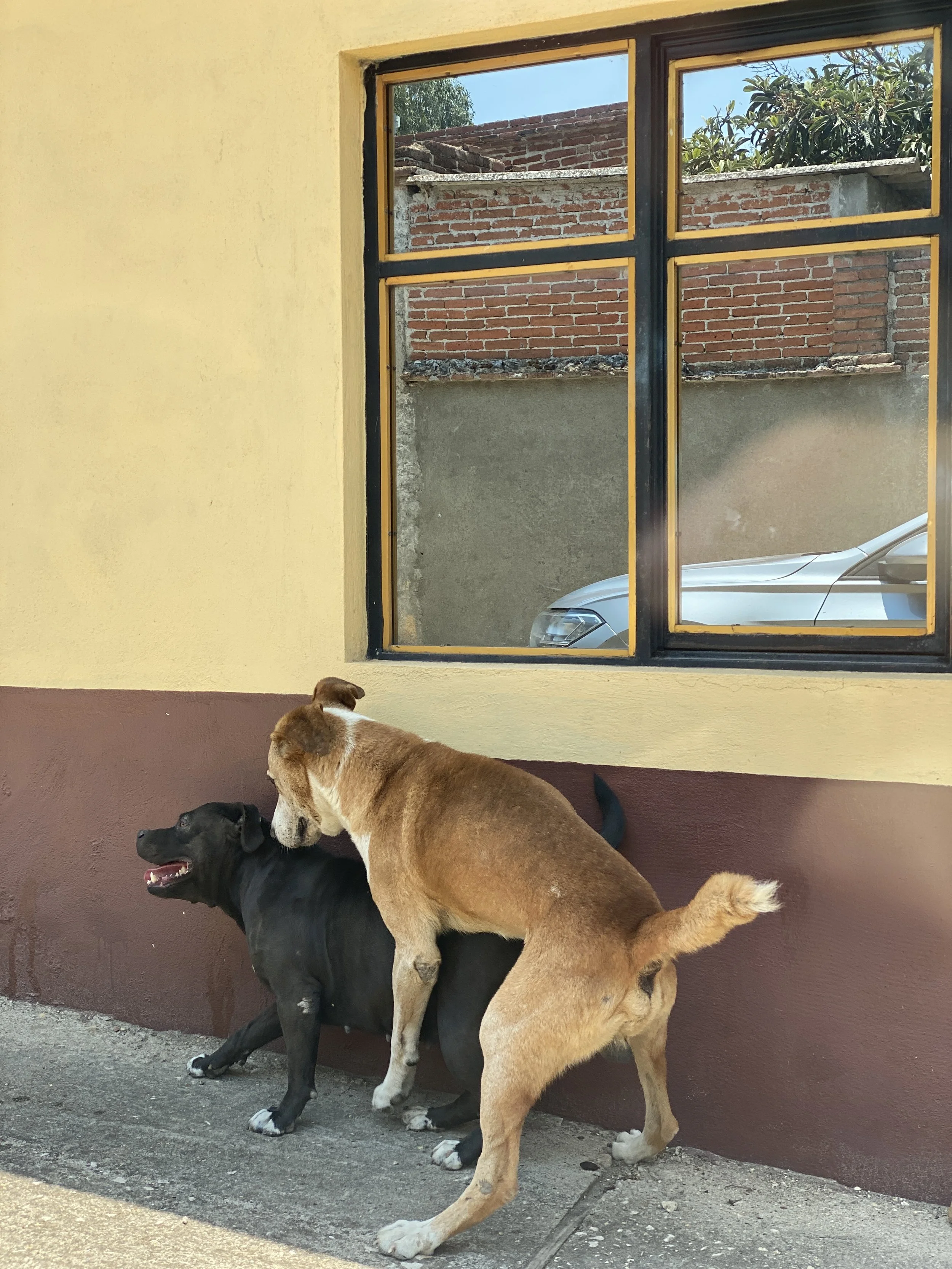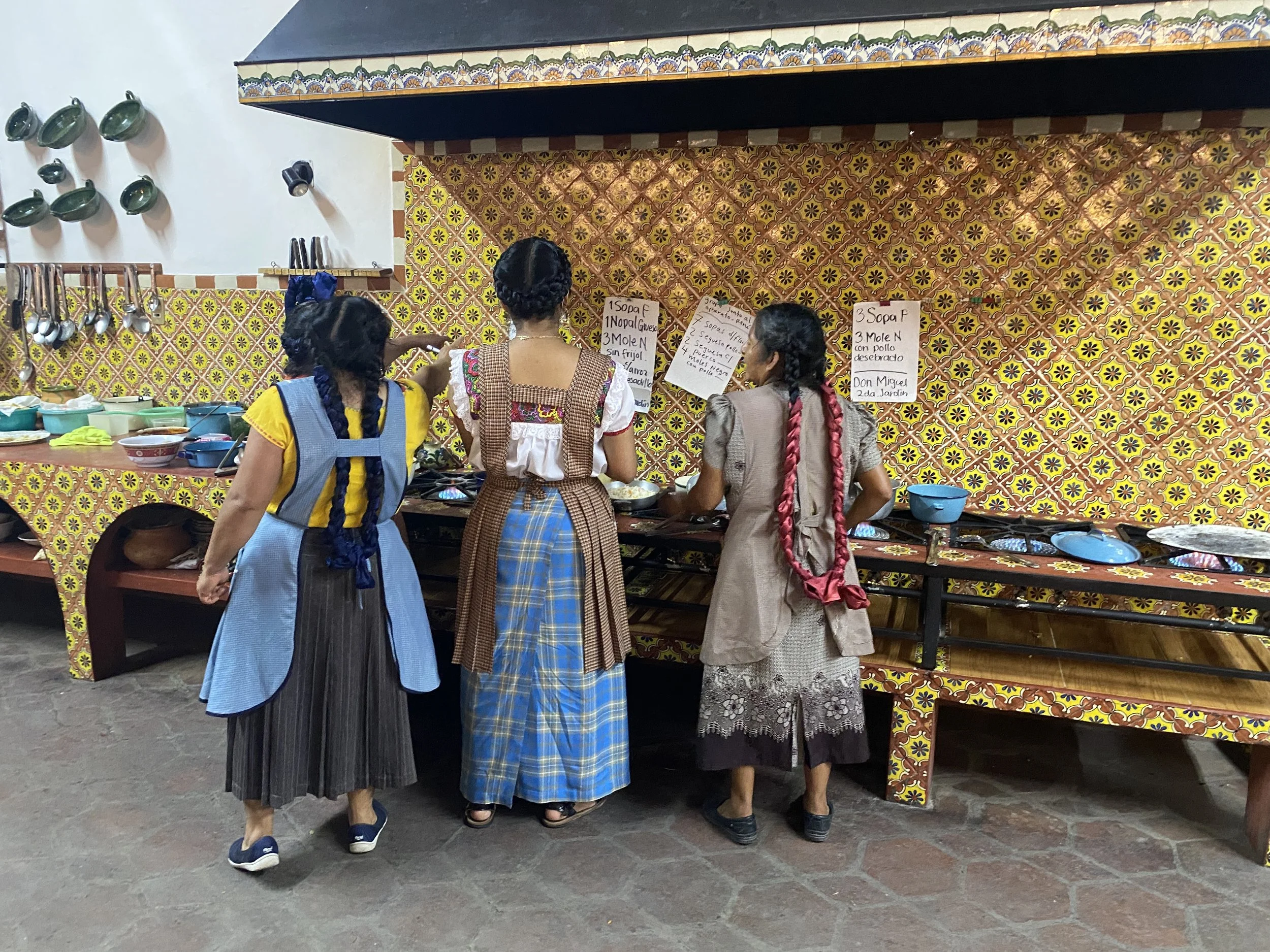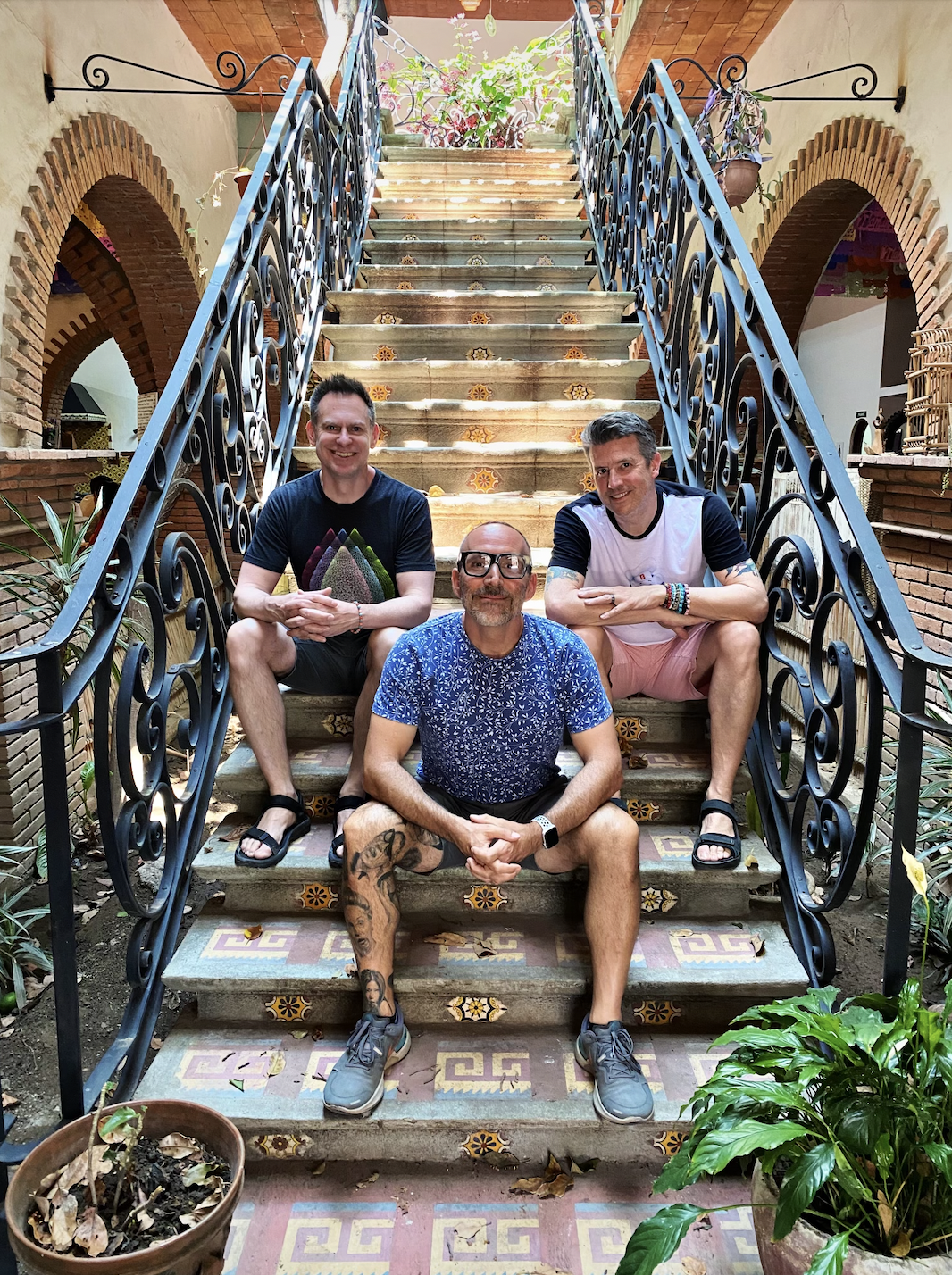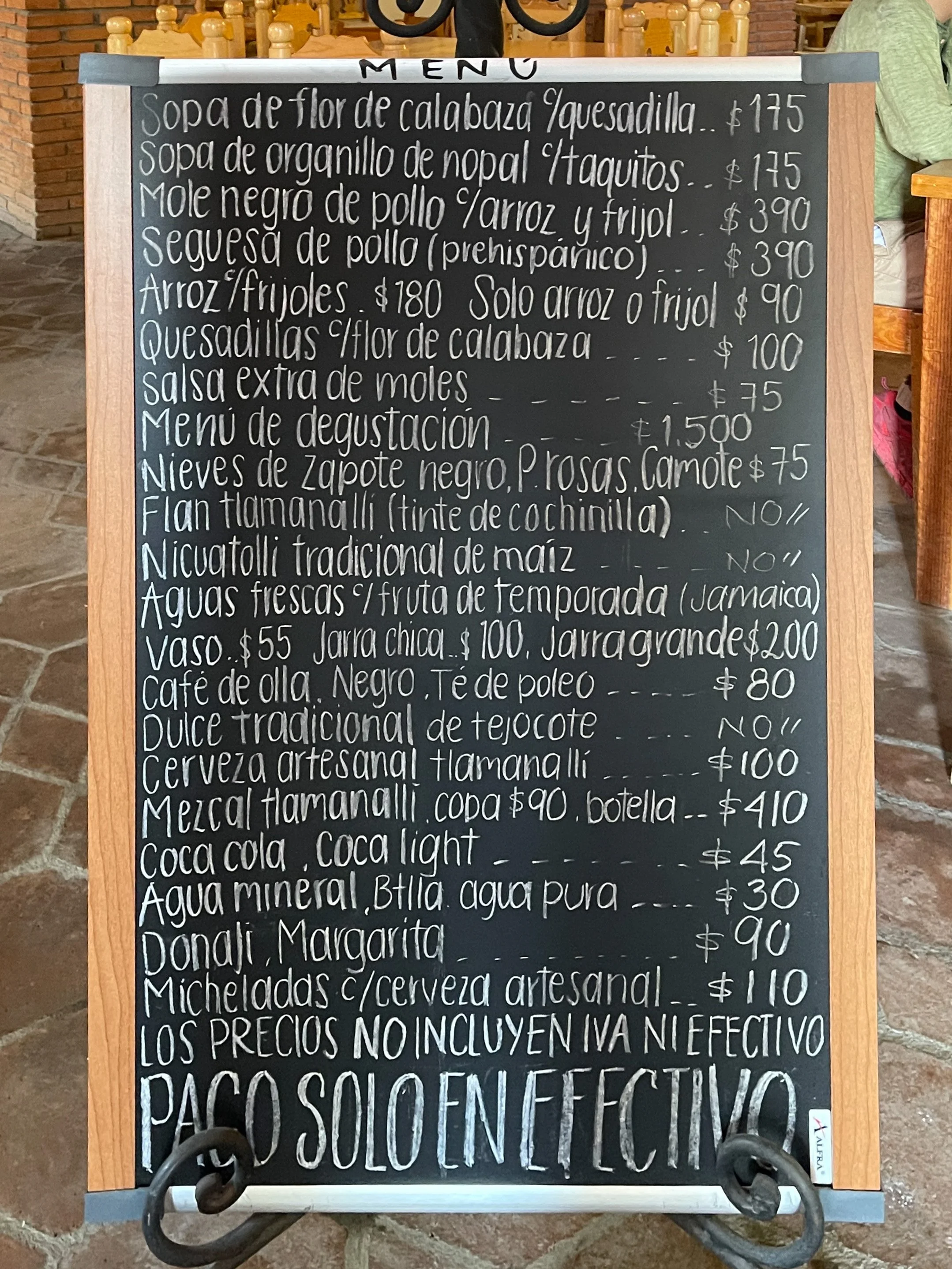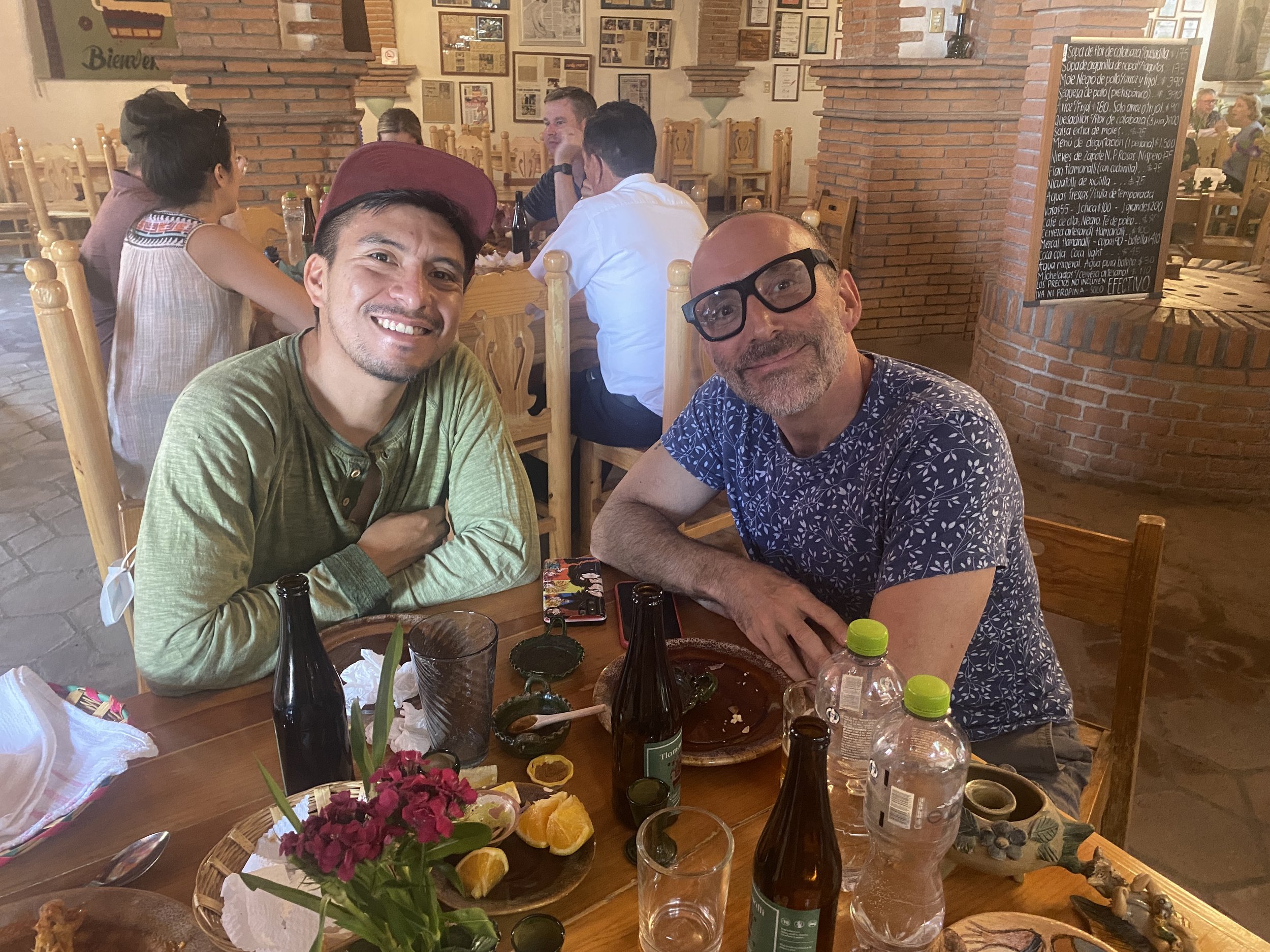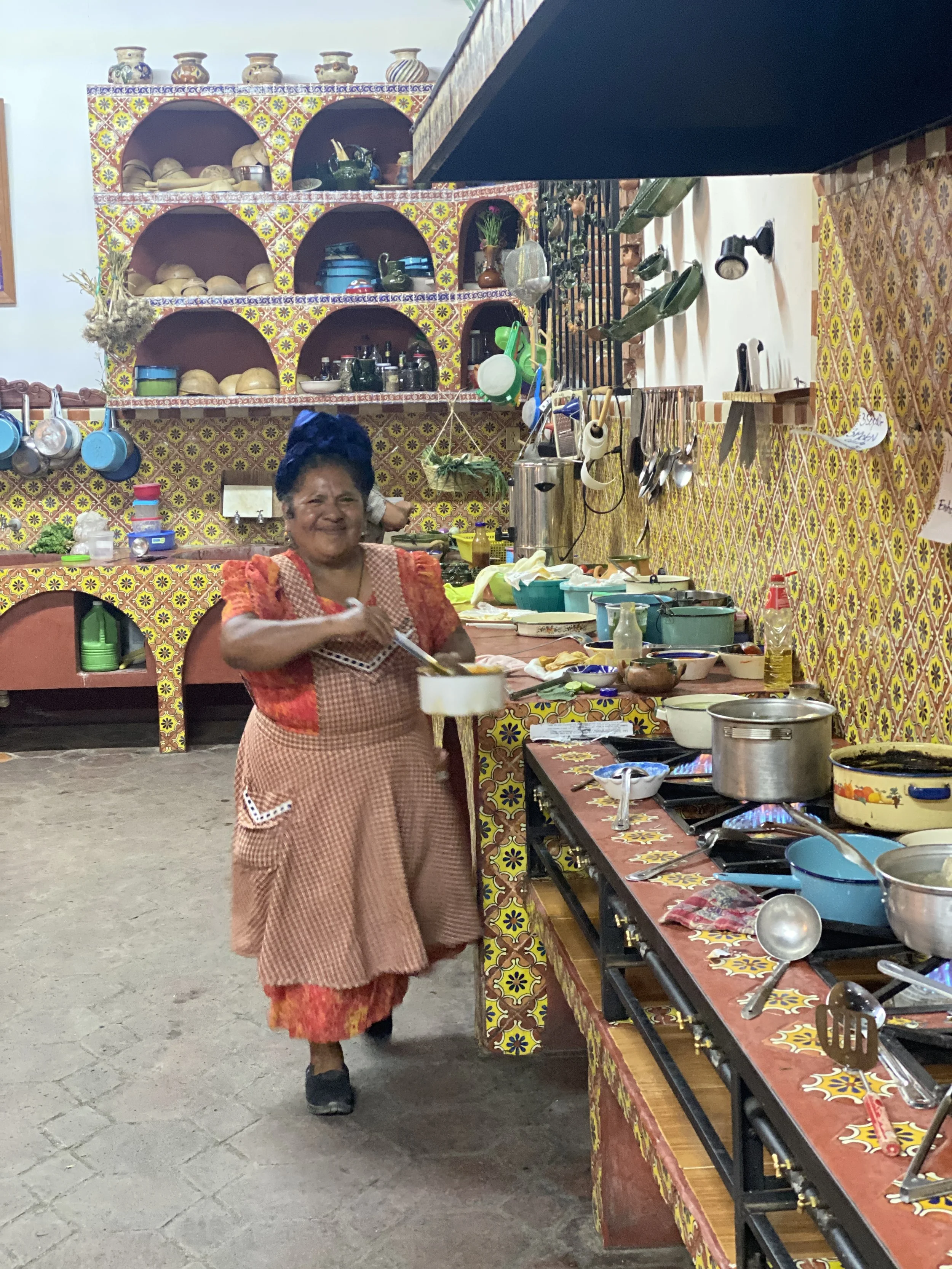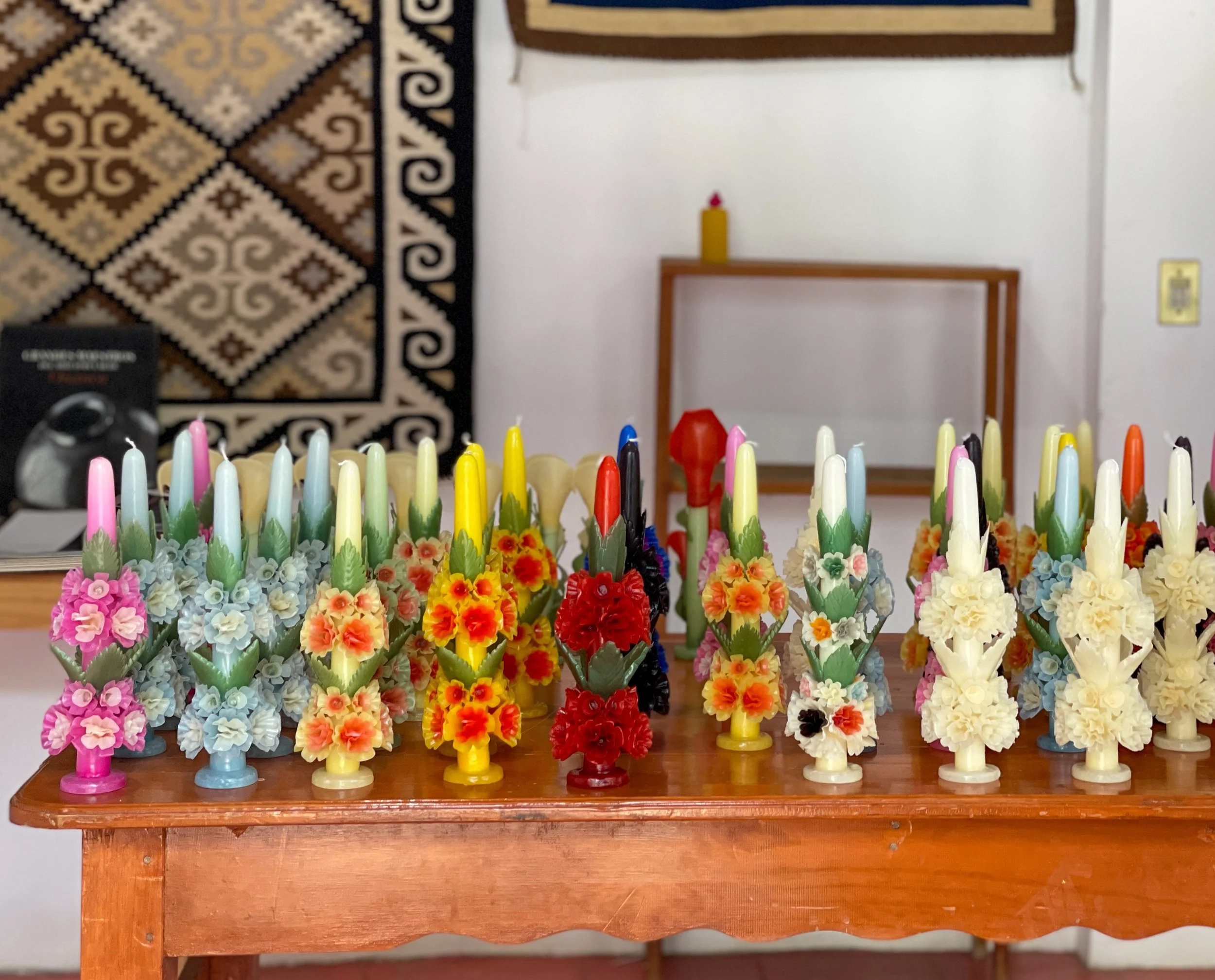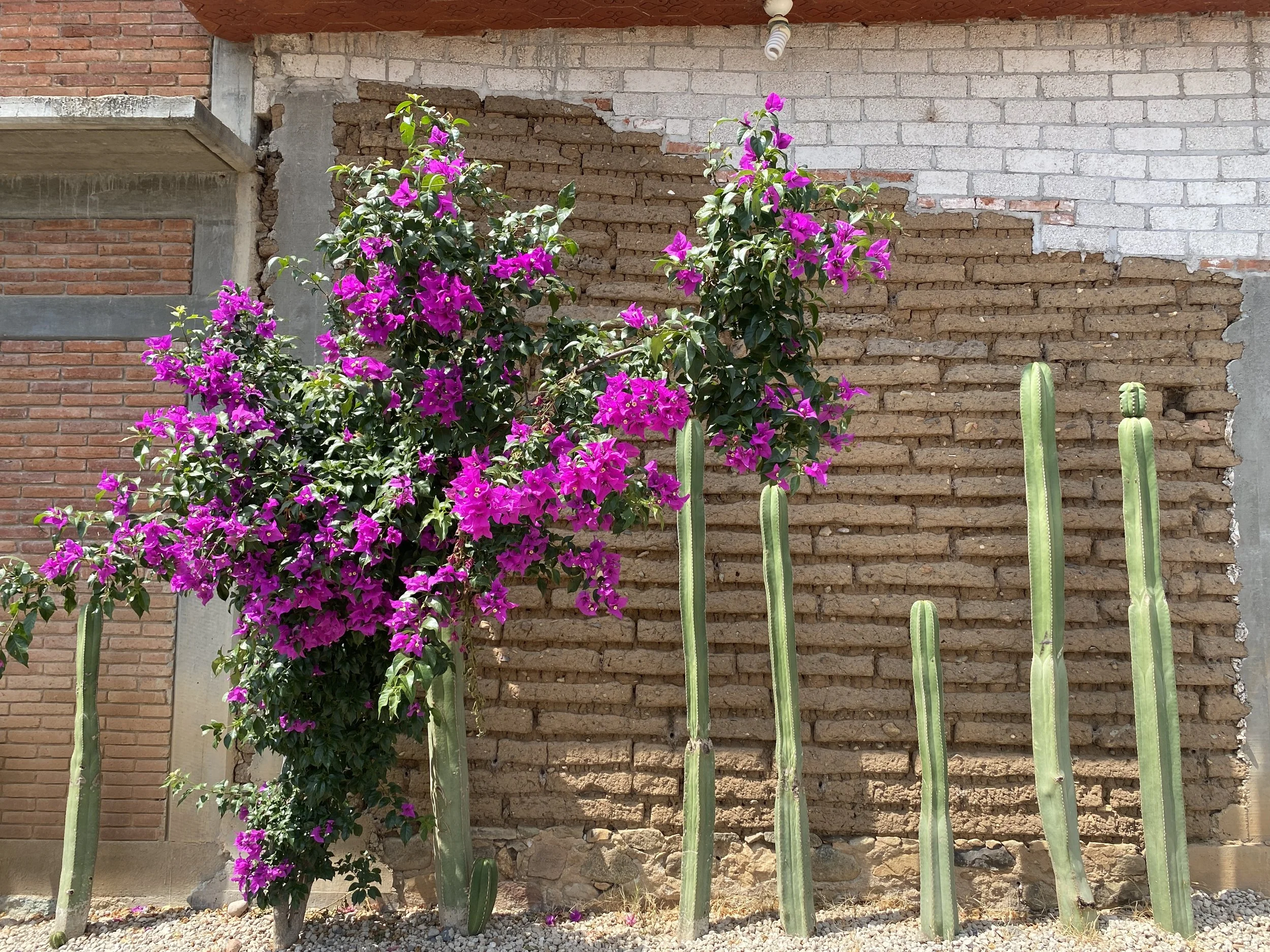First stop: the Iglesia de San Jerónimo Tlacochahuaya, with its heavenly rustic painted interior. Then on to Teotitlán del Valle for lunch at Tlamanalli and gorgeous candles from Casa Viviana.
This amazing church in San Jerónimo Tlacochahuaya, with its rustic paintings, is en route to the natural wonder of Hierve el Agua.
To say that there’s a vast amount of things to do and see in Oaxaca is an understatement. So when Wally and I agreed to take a day trip to Hierve el Agua, a natural mineral spring where water collects in clifftop pools, I insisted that we make a few stops along the way.
Driving is the best way to get around outside of town, and our friend Kevin, an expat living in Oaxaca de Juárez, kindly agreed to rent a car.
While driving in Oaxaca, you might have to stop to let herds of cattle pass by.
You also might see stray dogs in flagrante delicto.
We set out early and met him and his friend David at Alamo Rent a Car, which was a short walk from Casa Antonieta, where we were staying in Centro.
After a few minutes of waiting in line and filling out paperwork, we were ready to begin our adventure. It helped having a friend familiar with renting a vehicle in Oaxaca.
The lowdown: It cost us $75 for the day, including insurance.
Alamo Rent a Car
Mariano Matamoros 203 A
Ruta Independencia
Centro 68000
Oaxaca de Juárez
You can’t miss the church — it dominates the small village of San Jerónimo Tlacochahuaya.
Iglesia de San Jerónimo Tlacochahuaya: A Rustic Church Painted With Symbolism
Our first stop, about a half hour southeast from Centro Oaxaca, was the 16th century Iglesia de San Jerónimo Tlacochahuaya, aka the Templo de Tlacochahuaya, the centerpiece of the village of the same name. Try pronouncing it as “Tella-kocha-huh-why-uh” — a name that basically means “In the Swamp.” This is because the town is located in a valley surrounded by mountains, which makes it prone to flooding.
The pueblo was founded by a Zapotec warrior by the name of Cochicahuala, which translates to “He Who Fights by Night.”
A sculpture of Jesus on a donkey, representing how he entered Jerusalem, sits in the back corner of the iglesia and is used during a Palm Sunday procession.
We parked the car and walked along the outer wall surrounding the church. I could hear the rhythmic beat and swirling melody of an unseen drummer and woodwind player, which to me sounded a bit like music from a Renaissance Faire. This set the mood for our visit — it was like stepping back in time to an older, slower-paced pre-modern world.
The church’s main façade is made up of twin bell towers, pilasters (low-relief columns that project slightly from the surface), a split pediment and niches with sculptures of various saints. An image of Saint Jerónimo, or Saint Jerome, the church’s patron, is depicted above the central doorway, with God’s trumpet directed to his ear.
All of the walls inside the Templo Tlacochahuaya are covered with red, blue and tan painted designs.
This fresco portrait depicts Saint Mark seated atop a winged lion (which is actually a symbol of Venice, Italy).
San Jerónimo’s heavenly hand-painted interiors are a mix of Baroque and indigenous pre-Hispanic imagery. These include plants and flowers that arc overhead like garden arbors. Tones of blue were achieved using indigo extracted from the leaves of the plant and pink blush tones from cochineal, an insect that feeds on nopal cactus and produces the color carmine red.
We had driven all the way here — we weren’t going to let a Do Not Enter sign prevent us from popping in.
Offerings of flowers fill one smaller altar inside the chruch.
The main altarpiece is a stunning example of Plateresque style, which comes from the Latin word platearius, which means “silversmith.” A gilded golden masterpiece, the retablo includes a painting depicting the moment when Christ’s body was removed from the cross to be taken away for burial, and is attributed to Juan de Arrué, one of the most renowned religious artists of Mexico’s colonial era.
Wooden carvings, oil paintings, gilded frames and simplistic paintings create lovely vignettes.
A statue of the Virgin Mary with the Sacred Heart
We had only been inside for a short time before we were chased out by one of the church’s caretakers. The man spoke to us rapidly in Spanish that was too difficult for me to understand. Kevin mentioned that he thought the man may have been asking for a donation. In hindsight, it probably was due to the fact that there was a No Pasar sign posted at the entrance, which I had missed but Wally had pointedly ignored as we entered.
Iglesia de San Jerónimo Tlacochahuaya
Calle Unión 17
San Jerónimo Tlacochahuaya
The Mendoza sisters cook indigenous Zapotec cuisine at their restaurant, Tlamanalli.
A Taste of Zapotec Tradition at Tlamanalli
After visiting the church, we got back into the car. As we headed out of town, we saw two dogs having sex. We weren’t sure what kind of omen that was. At any rate, we were headed to our next stop, Teotitlán del Valle, 20 minutes away, and a short detour to the northeast. The artistic enclave is known for its high-quality woven goods — and candles (but more on that later).
Duke, Kevin and Wally sit on the staircase in the center of Tlamanalli.
First up: a delicious lunch at Tlamanalli. The restaurant came highly recommended by our primary care physician, Ross Slotten, who shares our passion for travel. The restaurant has been serving patrons for over three decades.
Using ancient culinary techniques and recipes that have been passed down through generations, Tlamanalli is co-owned and run by Maestra Abigail Mendoza Ruiz and her sisters, Marcelina, Rufina, Rosario and Adelina. The menu pays homage to indigenous Zapotec cuisine, a legacy that Mendoza Ruiz is recognized for internationally. The space, which is low-key and humble, feels like a large home, a deeply personal space that honors their familial bond.
The menu is limited and written on a small chalkboard. Wally and I each ordered the quesadillas de calabaza (pumpkin quesadillas) and washed it down with a cold beer.
The menu is written on a chalkboard —and note that you can only pay in cash.
Tlamanalli makes a great stop for lunch (and shopping) en route to Hierve el Agua.
A prominent feature of the establishment is its large open kitchen, which was designed by Mendoza Ruiz. The restaurant is off to one side of the central staircase, and the other side is a shop selling a wide variety of handmade items. We can never say no to artisan-made goods and ended up purchasing a plate with a mermaid sporting perky raised-relief breasts, a candle holder in the shape of an axolotl and a small winged ceramic devil ensnared by a serpent.
The adorable Abigail Mendoza Ruiz, whipping up dishes with her sisters in the restaurant’s open kitchen.
The restaurant is spacious and offers ample seating. However, we weren’t visiting during peak season, and due to the popularity of the spot, you might want to plan ahead and make reservations.
Open: 10 a.m. to 4 p.m.
Reservations recommended
Tlamanalli
39 Avenida Juárez
Teotitlán del Valle
Gorgeous handmade candles at Casa Viviana
Waxing Poetic About a Master Candlemaker: Casa Viviana
The real reason I wanted to visit Teotitlán was to meet the master candlemaker at Casa Viviana.
The legendary artisan and her family live on a quiet unpaved road. The only indication that we were at the right spot was a sign hanging outside an unassuming door leading into the living quarters, workshop and store.
But when we arrived, the front door was locked. We knocked loudly — I really didn’t want to go away disappointed — and eventually the door opened and we were led into the central courtyard.
Turns out we had interrupted a family celebration. But Doña Viviana Alávez, the matriarch of the family, graciously welcomed us into her shop.
Viviana herself came out to help us, briefly leaving a family party. We love the local tradition of connecting two long braids with ribbons.
Viviana is recognized as one of the grand masters of Oaxacan folk art. Her family has been making handmade beeswax candles for over 300 years. These remarkable works of art are mostly used for traditional celebrations, including baptisms, engagements, weddings and funerals.
Many of Viviana’s candles are bought for special occasions.
When we visited, Viviana didn’t have any big tapers left — the elaborate 4-foot-tall constructions I had seen in images and videos online. (Perhaps it was for the best — I’m not sure how we would have gotten one home.)
She did, however, have a variety of small intricate flower candles. The candles are known as velas tradicionales de concha, for the delicate shell-like shapes of their ornamentation and are made from wax that is cut, shaped and dyed with natural colorants like cochineal (red), indigo (blue) and pericón (yellow), which are added to the beeswax.
After some deliberation, we purchased a few of the small traditional velas to give as gifts as well as one shaped like a lily and one shaped like a cactus that came in a small ceramic pot for ourselves. The candles came to about $7.50 each — a small price to pay for these works of art.
The maestra herself: Viviana holds two of her works.
We passed a loom with nopal cactus paddles above it (those white bits are actually cochineal bugs used to make red dye).
Open: 11 a.m. to 6 p.m. (but maybe call ahead)
Casa Viviana
Absalo s/n
Teotitlán del Valle
With our purchases safely packaged by Doña Viviana, we said our goodbyes and returned to the car. It was time for us to continue our trip to the popular tourist destination of Hierve el Agua. –Duke



